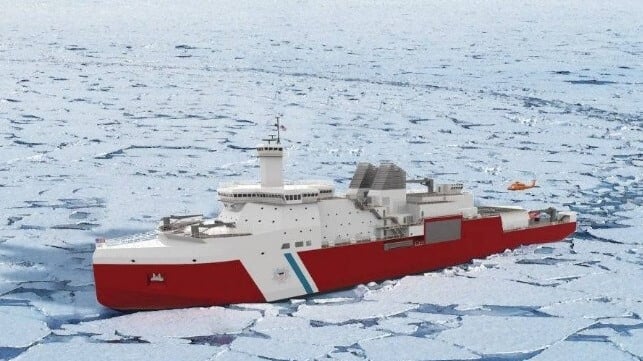Report: USCG’s Polar Icebreaker Program is 60 Percent Over Budget

The project procurement costs for the U.S. Coast Guard’s new Polar Security Cutter program are expected to be 60 percent greater than the Coast Guard’s latest estimates. This is the finding that will be shared next week by an analyst from the Congressional Budget Office (CBO) during a hearing in front of the Transportation and Maritime Subcommittee of the U.S. House of Representatives’ Committee of Homeland Security.
An advance copy of the opening statement by Eric Labs, Senior Analyst for Naval Forces and Weapons, provides the details of the Polar Security Cutter program review requested by the subcommittee. He will tell the committee that the full report is currently being drafted and is expected to be published this summer.
The cutter program has been beset with delays and cost overruns by the Coast Guard’s admission. They first proposed replacing the Polar Star (commissioned in 1976) and the Healy (commissioned in 1999) in 2013. The original plan called for three heavy polar icebreakers and three medium icebreakers, with the Coast Guard more recently emphasizing the urgency of the need as they only have the two cutters, both of which are beyond their normal expected age forcing them to undertake various life extension efforts. In the case of the Polar Star, the Coast Guard is scrounging parts from her idled sister ship Polar Sea. Healy required a massive engine replacement job in 2020 after one of her main engines failed.
The contract for the lead vessel, a heavy icebreaker was awarded in April 2019 to VT Halter Marine, which was later acquired by Bollinger. Design work is ongoing having experienced numerous delays in part due to the pandemic and in part problems in the program. The Government Accountability Office (GAO) issued a critical report in July 2023 citing numerous problems and calling for changes in the process of managing the project. GAO forecast it would be at least March of this year before the designs were matured.
The U.S. Coast Guard has repeatedly told Congress that the delays were expected due to the complexity of the project while the shipyard notes the U.S. has not built a vessel of these capabilities in many years. They highlighted work on test sections to demonstrate the growing capabilities and progress of the project.
The subcommittee asked the CBO to prepare its report as the Coast Guard said in February 2024 that it expected the cost of the program would exceed previous estimates by more than 20 percent. They also delayed by more than a year the ship’s production schedule and projected commissioning. The CBO is now telling the subcommittee that it expects substantial construction on the lead ship could start within a year while they project an estimated delivery date in 2029.
CBO used the same methods it employed to estimate the costs of navy ships, calculated from a cost-to-weight ratio. For the polar icebreaker, they chose to work off the history of the Healy, which while smaller, was built in the 1990s versus the early 1970s for the Polar Star. They recognize the new ship will be about 23,000 tons making it significantly larger than the Healy which is 16,000 dwt or the Polar Star which is 13,200 dwt.
They calculated that the projected cost would be about $1.9 billion for the first new vessel. Assuming there are cost savings in the project due to reductions in the overhead costs for the second and third vessels and shipyard efficiencies as the project progresses, CBO projects the second and third vessels at $1.6 billion each or a total cost for the project of $5.1 billion. That is 60 percent beyond the USCG March 2024 estimate, with the Coast Guard having promised to update its cost estimates later this year based on the progress in the program.

that matters most
Get the latest maritime news delivered to your inbox daily.
The report also highlights that the U.S. Coast Guard has revised its estimates as to what will be required based on the increased commercial activity and economic and geopolitical competition in the Arctic. To maintain a year-round presence in the East and West Arctic and half a year presence in the Antarctic, the Coast Guard says it will need a total of eight or nine ships. They are proposing four or five heavy icebreakers and four or five medium polar icebreakers.
Today, Representative Carlos Gimenez (R-FL), chairman of the subcommittee announced the hearing scheduled for May 7, reporting they will examine the U.S. Coast Guard’s shipbuilding and acquisitions process, the state of efforts to modernize the service’s fleet, and ways in which the Department of Homeland Security (DHS) can facilitate faster turnaround times for USCG acquisitions programs.
